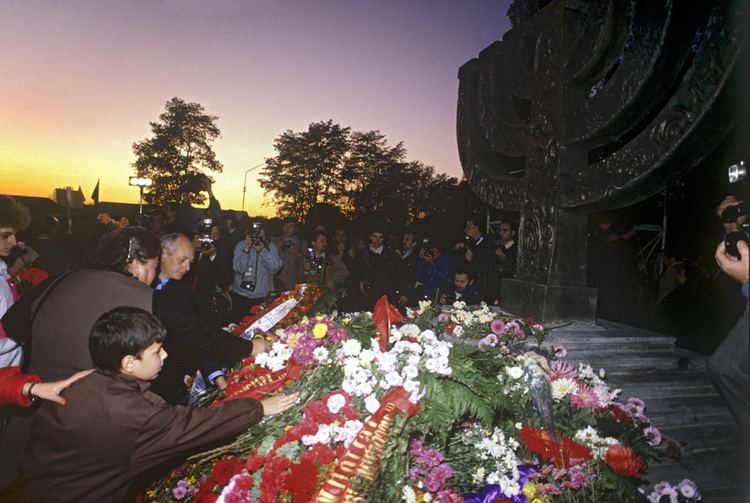 | ||
Babi Yar, a ravine near Kiev, was the scene of possibly the largest shooting massacre during the Holocaust. After the war, commemoration efforts encountered serious difficulty because of the policy of the Soviet Union. After the dissolution of the Soviet Union, a number of memorials have been erected. The events also formed a part of literature.
Contents
Commemoration and Soviet policy
Soviet leadership discouraged placing any emphasis on the Jewish aspect of the Babi Yar tragedy; instead, it presented these atrocities as crimes committed against the Soviet people in general and the inhabitants of Kiev in particular. The first draft report of the Extraordinary State Commission (Чрезвычайная Государственная Комиссия), dated December 25, 1943 was officially censored in February 1944 as follows:
Monuments Erected At Babi Yar
Several attempts were made to erect a memorial at Babi Yar to commemorate the fate of the Jewish victims. All attempts were overruled. An official memorial to Soviet citizens shot at Babi Yar was erected in 1976. This remembrance is still complicated in the great numbers and many sorts of persons murdered there.
After the dissolution of the Soviet Union in 1991, the Ukrainian government allowed the establishment of a separate memorial specifically identifying the Jewish victims.
The monuments to commemorate the numerous events associated with Babi Yar tragedy include:
(This list is not comprehensive.)
There is also a proposal to remember the thousands of Roma (Gypsies) killed at Babi Yar by erecting a monument designed as a Gypsy wagon. However, the plan has yet to gather a sufficient financial and administrative support.
Desecration of the memorial complex (July 2006)
On the night of July 16, 2006, the memorial dedicated to the Jewish victims was vandalized. Several gravestones, the foundation of the commemorative sledge-stone, and several steps leading to the Menorah memorial were damaged. The Ministry of Foreign Affairs of Ukraine issued a statement condemning the act of vandalism.
Other memorials
The President of the Babi Yar Park Foundation Alan G. Gass stated:
We built a memorial park to the Babi Yar massacre in Denver, Colorado. It was dedicated in 1982, with an inscribed black granite entrance gateway, a "People Place" amphi-theatre, a "Forest that Remembers" with a spring flowing all year in the middle, and a high-walled, narrow black bridge over a ravine, all at three points of a Magen David carved out of the native prairie grasses. It is owned and maintained by the City & County of Denver. The park is used by the recently arrived immigrants from Russia and the former Soviet Union as a place of remembrance during the year and with a special ceremony on 29 September each year.
There is a memorial to the victims of Babi Yar at the Nahalat Yitzhak Cemetery in Giv'atayim. The memorial was erected over bone fragments from Babi Yar that were reinterred at the cemetery. The bones were brought out of Ukraine by three American college students in July 1971. The memorial was dedicated in 1972 by the Prime Minister of Israel, Golda Meir. There is an annual ceremony on Yom HaShoah, the Holocaust Day.
A memorial to the victims of the Babi Yar Massacre was erected in the Sydney suburb of Bondi on 28 September, 2014, which has a large Russian-speaking Jewish community. The monument was unveiled by the Mayor of Waverley and the Federal Member, Malcolm Turnbull. The erection of the monument was an initiative of the Executive Council of Australian Jewry and its Public Affairs Director, Alexander Ryvchin, who was born in the city of Kiev, where the massacre took place. The English portion of the inscription on the monument reads:
"In memory of the Jews of Kiev, massacred at Babi Yar by the Nazis and their Ukrainian Collaborators, and in recognition of the suffering of Soviet Jewry."
Literature and film
In his 1961 book Star in Eclipse: Russian Jewry Revisited, Joseph Schechtman provided an account of the Babi Yar tragedy. In 1966, Anatoly Kuznetsov's Babi Yar: A Document in the Form of a Novel was published in censored form in the Soviet monthly literary magazine Yunost. Kuznetsov began writing a memoir of his wartime life when he was 14. Over the years he continued working on it, adding documents and eyewitness testimony. He managed to smuggle 35 mm photographic film containing the uncensored manuscript when he defected, and the book was published in the West in 1970.
In 1985, a documentary film Babiy Yar: Lessons of History by Vitaly Korotich was made to mark the tragedy.
The massacre of Jews at Babi Yar has inspired a number of creative ventures. A poem was written by the Russian poet Yevgeny Yevtushenko; this in turn was set to music by Dmitri Shostakovich in his Symphony No. 13. An oratorio was composed by the Ukrainian composer Yevhen Stankovych to the text of Dmytro Pavlychko (2006). A number of films and television productions have also marked the tragic events at Babi Yar, and D. M. Thomas's novel The White Hotel uses the massacre's anonymity and violence as a counterpoint to the intimate and complex nature of the human psyche.
